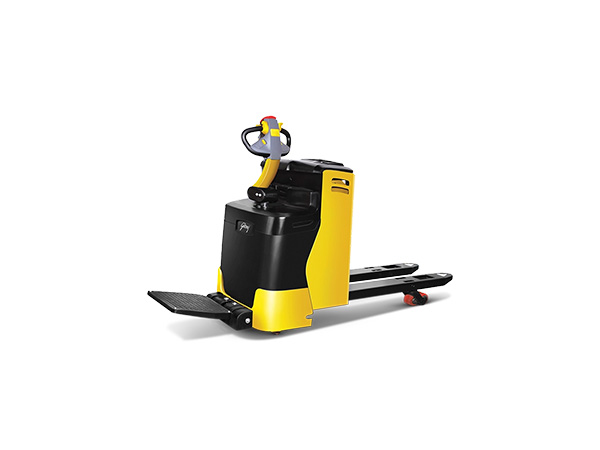VMPL
New Delhi [India], July 10: There comes a point when manual work in a warehouse just isn't enough. If you've spent any time running a warehouse or managing floor operations, you've probably felt it. It's usually when you're still relying on manual pallet trucks to do most of the heavy lifting. That's when you know it's time to take a closer look at electric stackers. And not just any stackers, we're talking about purpose-built machines from trusted companies like the Godrej Enterprises Group.
From Hard Push to Powered Precision
Manual pallet trucks do the job, but only up to a point. They're fine for low volumes, flat floors, and short runs. But as soon as things get busier, with higher racks, tighter timelines, and longer shifts, they start to fall short.
That's where electric stackers change the game. The stacker handles the load, steers smoothly, and lifts high with control. Everything feels more stable. Your team isn't drained by midday, and productivity holds steady throughout the shift.
It's not about replacing workers. It's about making their work easier, faster, and safer.
Designed with the Floor in Mind
Many machines look good on paper but don't perform the same way once they hit Indian floors - dusty surfaces, narrow aisles, and mixed load sizes. What differentiates the Godrej Enterprises Group is how their electric stackers are designed for these exact conditions.
Whether it's the Godrej UNO Electric Stacker 1.5 tonne or the 1.2 tonne model, you'll see the difference in the details. These machines are built for people who deal with real-world warehouse issues like tricky corner turns or unloading on slightly uneven floors.
They hold up over time as well. Battery life doesn't drop off after a few months, and charging systems are built to be energy-efficient. The stackers can handle multiple shifts without cutting corners on performance. In other words, they're not just made for occasional use, but daily usage.
Why Safety Isn't Just a Feature, But a Reason
If you've seen even one back injury on the shop floor, you know how easily things can go wrong. With manual pallet trucks, it doesn't take much. One bad angle, one overloaded pallet, one distracted moment, that's all it takes. Electric stackers reduce that risk dramatically. You're not pulling tonnes of weight and not forcing turns or jerking to a stop. The machine does the hard part. Your operator stays focused, with better posture and less physical strain. Accidents drop, and so does absenteeism.
Machines like the Godrej Crown ES/ET 4000 series come with built-in safety features. This includes emergency stop buttons, soft start, and controlled acceleration. These aren't just add-ons, they're what make electric stackers the safer choice, especially if your team works long shifts or handles heavy loads regularly.
Costs That Make Sense in the Long Run
A manual pallet truck costs less upfront. You may get a decent one for around Rs 20,000, but if you look beyond that initial price tag, the story changes.
Over time, manual trucks slow down operations. They need more manpower. You spend more time and energy moving the same number of loads. And that costs money.
Electric stackers, like the Godrej Electric Stacker 1.5 tonne, may seem like a bigger investment. But they deliver more - more uptime, more speed, and more reliability. You can move more goods with fewer people.
And the best part is that maintenance isn't a headache. With proper servicing, these machines run smoothly, and downtime stays low. Over a few years, they don't just pay for themselves; they make your entire setup more efficient.
Ideal for Growing Warehouses and Expanding Workflows
Electric stackers aren't just for sprawling distribution centres. In fact, they often make the biggest difference in warehouses that are scaling up.
If your operations have grown beyond what a basic manual pallet truck can handle, but you're not quite at the stage where you need a full forklift fleet, this is where electric stackers shine. Models like the Godrej UNO Electric Stacker 1.5 tonne or the 1.2 tonne stacker are compact enough to work in narrow aisles and tight storage zones. At the same time, they have the lifting capacity and battery strength to support full-day operations with ease.
Training isn't complicated, either. The controls are simple, so your team doesn't need to be highly skilled operators to use them well. This makes the transition smoother for businesses that are upgrading equipment gradually.
If your workflow has outgrown manual systems but your space or budget can't yet support full-scale forklifts, an electric stacker fits that middle ground perfectly. It brings structure, consistency, and a level of automation without disrupting your existing setup. And that's a practical way to future-proof your floor operations.
Conclusion
Manual pallet trucks to electric stackers aren't a flashy upgrade; it's a practical move, a sign that your operations are maturing and that you value time. And if you're looking at brands, trust matters. The Godrej Enterprises Group isn't new to this space. They've built machines that last and, more importantly, that fit Indian conditions, something international brands often miss. At the end of the day, it's about getting more done with less effort and less risk.
(ADVERTORIAL DISCLAIMER: The above press release has been provided by VMPL. ANI will not be responsible in any way for the content of the same)

